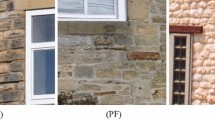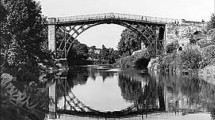Abstract
An inherent weakness of masonry structures is low bond and bond strength. Although masonry bond is a result of many interrelated factors (e.g. surface texture, surface absorption and mortar composition, etc.), surface absorption of masonry units has a significant effect on masonry bond. Following a critical review of the current measurements of the surface absorption of masonry units, the theoretical bases of sorptivity as a measurement of surface absorption are presented. The limitations of sorptivity measurement are discussed through a review of the application of the concept of sorptivity to different porous building materials. An experimental programme to examine the surface absorption of masonry units is described. Analysis of the results showed sorptivity to be a simple and reliable measurement of surface absorption for masonry units that could be used in building standards.
Résumé
L'une des faiblesses inhérentes des ouvrages en maçonnerie réside dans le manque de lien et le manque de solidité du lien. Malgré le fait que le lien de maçonnerie soit le résultat de plusieurs éléments mis en corrélation (par exemple, l'état de la surface, le degré d'absorption de la surface, la composition du mortier, etc.), le degré d'absorption de la surface des unités de maçonnerie a un effet important sur ce lien. À la suite d'un examen critique des méthodes actuelles de mesure du degré d'absorption de la surface des unités de maçonnerie, les bases théoriques de la sorptivité comme méthode de mesure du degré d'absorption de la surface sont présentées. Les limites de la mesure de la sorptivité sont discutées en réexaminant l'application du concept de sorptivité à divers matériaux de construction poreux. Un programme expérimental ayant pour but d'examiner le degré d'absorption de la surface des unités de maçonnerie est décrit. L'analyse des résultats a démontré que la sorptivité est une méthode simple et fiable de mesure du degré d'absorption de la surface pour les unités de maçonnerie, et devrait être introduite dans les nouveaux codes de construction des bâtiments.
Similar content being viewed by others
References
Goodwin, J. F. and West, W. H., “A review of the literature on brick/mortar bond’,Proceedings of the British Ceramic Society 30 (23) (1982) 23–37.
Sugo, H. O., ‘Strength and microstructural characteristics of brick/mortar bond’, Ph.D. Dissertation, Department of Civil, Surveying and Environmental Engineering, The University of Newcastle, (Newcastle, Australia, 2001).
McGinley, W. M., ‘IRA and the flexural bond strength of clay brick masonry’, in ‘Masonry: Components to assemblages’, Matthys, J.H., Ed., ASTM STP 1063. 1990 (American Society for Testing and Materials, PA, USA) 217–234.
Lange, D. A., Deford, H. D. and Ahmed, A., ‘Microstructure and mechanisms of bond in masonry’, Proceedings of Seventh North American Masonry Conference, University of Notre Dame, (South Bend, Indiana, USA, 1996) 167–174.
Voss, W. C., ‘Permeability of brick masonry walls—A hypothesis’,ASTM Proceedings 33 (1933) 670p.
Anderegg, F. O., ‘The effect of brick absorption characteristics upon mortar properties’,ASTM Proceedings 42 (1942) 821 p.
Morgan, J. W., ‘Brick absorption’,Archietecture Science Review 20 (3/4) (1977) 66 p.
Lawrence, S. J. and Cao, S., ‘The influence of some factors on the tensile bond strength of masonry’, Proceedings of the 10th International Brick and Block Masonry Conference (IB2MaC), Shrive, N. G. and Huizer, A., Ed., (Calgary, Canada, 1994) 929–938.
Groot, C. J. W. P., ‘The characteristics of brick and mortar considering mortar/brick bond’, Proceedings of the 11th International Brick/Block Masonry Conference (IB2MaC), Tongji University, Shanghai, China, 1997) 50–58.
Lawrence, S. J. and Page, A. W., ‘Bond studies in masonry’, Proceedings of the 10th International Brick and Block Masonry Conference (IB2MaC), Shrive, N. G. and Huizer, A., Ed., (Calgary, Canada, 1994) 909–917.
Philip, J. R., ‘The theory of infiltration: 4. Sorptivity and algebraic infiltration equations’,Soil Sciences 84 (1957) 257–264.
Gummerson, R. J., Hall, C. and Hoff, W. D., ‘Water movement in porous building materials—II. Hydraulic Suction and Sorptivity of Brick and Other Masonry Materials’,Building and Environment 15 (1980) 101–108.
Hall, C., ‘Water sorptivity of mortars and concretes: a review’,Magazine of Concrete Research 41 (147) (1989) 51–61.
Hall, C. and Yau, M. H. R., ‘Water movement in porous building materials—IX. The water absorption and sorptivity of concretes’,Building and Environment 22 (1) (1987) 77–82.
Jansson, I., ‘Testing the rate of water absorption’, Proceedings of the RILEM/CIB Symposium on Moisture Problems in Building, (Helsinki, Finland, 1965), 2, 10 p.
Sneck, T., ‘Dependence of masonry properties on the interaction between masonry units and mortar’, Proceedings of North American Masonry Conference, Noland, J. L. and Amrhein, J. E., Ed., (Colorado, USA, 1978) 21.1–21.12.
Hall, C., ‘Water movement in porous building materials—I. Unsaturated flow theory and its applications’,Building and Environment 12 (1977) 117–125.
Hall, C., Hoff, W. D. and Skeldon, M., “The sorptivity of brick: dependence on the initial water content’,Journal of Physics, D: Applied Physics 16 (1983) 1875–1880.
Hall, C., Hoff, W. D. and Nixon, M. R., “Water movement in porous building materials: VI. Evaporation and drying in brick and block materials’,Building and Environment 19 (1) (1984) 13–20.
Ho, D. W. S. and Lewis, R. K., ‘The water sorptivity of concretes: the influence of constituents under continuous curing’,Durability of Building Materials 4 (3) (1987) 241–252.
Kelham, S. A., ‘A water absorption test for concrete’,Magazine of Concrete Research 40 (143) (1988) 106–110.
Hooton, R. D. and Beal, D., ‘Sorptivity: measure of concrete durability’,Physical Infrastructure Center, The Latest in Civil Engineering Research from QUT. 1 (4) (1992) 6–7.
Bentur, A. and Jaegermann, C., ‘Effect of curing and composition on the properties of the outer skin of concrete’,Journal of Materials in Civil Engineering 3 (4) (1991) 252–262.
Hooton, R. D. and El-Dieb, A. S., ‘Permeability and permeability measurement—Are we any further ahead?, Advances in Cement and Concrete, Proceedings of an Engineering Foundation Conference, (Durham, New Hampshire, USA, 1994) 24–29.
Hooton, R. D., Mesic, T. and Beal, D. C., ‘Sorptivity testing of concrete as an indicator of concrete durability and curing efficiency’, Proceedings of the Third Canadian Symposium on Cement and Concrete, (Ottawa, Ontario, Canada, 1993) 264–275.
Groot, C. J. W. P., ‘First minutes water transport from mortar to brick’, Proceedings of the 9th International Brick/Block Masonry Conference (IB2MaC), (Berlin, Germany, 1991) 71–78.
DeSouza, S. J., Hooton, R. D. and Bickely, J. A., “Evaluation of laboratory drying procedures relevant to field conditions for concrete sorptivity measurements’,Cement, Concrete, and Aggregates 19 (2) (1997) 59–63.
American Society for Testing and Materials, Standard Test Method for Measurement of Initial Rate of Absorption of Hydraulic Cement Mortars and Concretes, ASTM draft # 9, 1996, 8 p.
Sabir, B. B., Wild, S. and O'Farrell, M., ‘A water sorptivity test for mortar and concrete’,Mater. Struct. 31 (1998) 568–574.
American Society for Testing and Materials, Standard Methods of Sampling and Testing Brick and Structural Clay Tile, ASTM C 67-86, 1986, 51–61.
Author information
Authors and Affiliations
Additional information
Editorial Note Dr. Mahmoud M. Reda Taha is a RILEM Affiliate Member.
Rights and permissions
About this article
Cite this article
Taha, M.M.R., El-Dieb, A.S. & Shrive, N.G. Sorptivity: a reliable measurement for surface absorption of masonry brick units. Mat. Struct. 34, 438–445 (2001). https://doi.org/10.1007/BF02482291
Received:
Accepted:
Issue Date:
DOI: https://doi.org/10.1007/BF02482291




